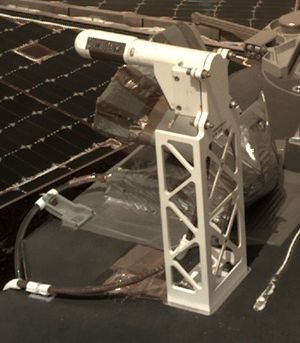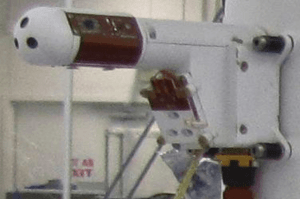Temperature and Winds for InSight facts for kids

TWINS sensor
|
|
| Operator | NASA / Jet Propulsion Laboratory |
|---|---|
| Manufacturer | Spanish Astrobiology Center (CSIC-INTA) |
| Instrument type | Atmospheric sensors |
| Function | Meteorology suite |
| Mission duration | 2 years (planned) |
| Began operations | 26 November 2018, 19:52:59 UTC (landing) |
| Host spacecraft | |
| Spacecraft | InSight |
| Operator | NASA / JPL |
| Launch date | 5 May 2018, 11:05 UTC |
| Rocket | Atlas V 401 |
| COSPAR ID | 2018-042A |
The Temperature and Winds for InSight (TWINS) is a set of special tools on the InSight lander. This lander, sent by NASA, landed on Mars on November 26, 2018. TWINS acts like a weather station for Mars. It constantly measures how fast the wind blows and the air temperature. These measurements help scientists understand the ground shaking data from another tool called Seismic Experiment for Interior Structure (SEIS). The TWINS tools were built by the Spanish Astrobiology Center in Madrid, Spain.
Contents
What is TWINS and How Does It Work?
TWINS is a very important part of the InSight mission. It helps scientists learn about the weather on Mars. This tool is similar to one used on the Curiosity rover, called REMS. TWINS is even better at measuring wind and temperature.
Why Study Mars' Weather?
The main goal of the InSight mission is to study the inside of Mars. However, understanding Mars' atmosphere (its air) is also very important. InSight gives us a continuous record of air pressure, temperature, and wind. This information is more detailed than what previous missions have collected.
Sensors on TWINS
TWINS has several sensors that collect data:
- Thermometers: These measure the air temperature.
- Anemometer: This tool measures how fast the wind is blowing and its direction. It takes readings twice every second!
- InSight FluxGate (IFG) Magnetometer: This sensor measures magnetic fields. It helps understand magnetic fields caused by Mars' atmosphere. The University of California, Los Angeles (UCLA) provided this sensor.
- Pressure Sensor (Barometer): This very sensitive tool measures air pressure. The Jet Propulsion Laboratory (JPL) provided it.
All this information about wind, temperature, pressure, and magnetic fields helps scientists. It helps them understand the local wind patterns at the landing site. This understanding is key to interpreting the data from the SEIS instrument.
Observing Martian Weather Events
The InSight lander also uses its cameras to watch the Martian sky. It looks for cirrus clouds high above a flat area called Elysium Planitia. It also watches for any fog near the ground. Sometimes, it even spots dust devils, which are like small tornadoes of dust.
By combining all this data, scientists learn more about Mars' weather and climate. This information adds to what other missions have found. It also works with the data that the Curiosity rover is still collecting about 600 kilometers (about 370 miles) to the south.
Auxiliary Payload Sensor Suite (APSS)
TWINS is part of a larger group of tools called the Auxiliary Payload Sensor Suite (APSS). Think of APSS as the complete "weather station" for InSight. It includes:
- TWINS: The temperature and wind sensor. It was developed by the Spanish Astrobiology Center (CAB) in Madrid, Spain.
- IFG: The InSight FluxGate magnetometer. This was developed by the University of California at Los Angeles (UCLA) in the USA.
- PS: The Pressure sensor. This was developed by the TAVIS company in the USA.
- PAE: The electronics that control the TWINS, PS, and IFG sensors. JPL developed these electronics.
See also
 In Spanish: Temperature and Winds for InSight para niños
In Spanish: Temperature and Winds for InSight para niños
- Atmosphere of Mars
- Climate of Mars
- Geology of Mars
- Rover Environmental Monitoring Station, on board the Curiosity rover


